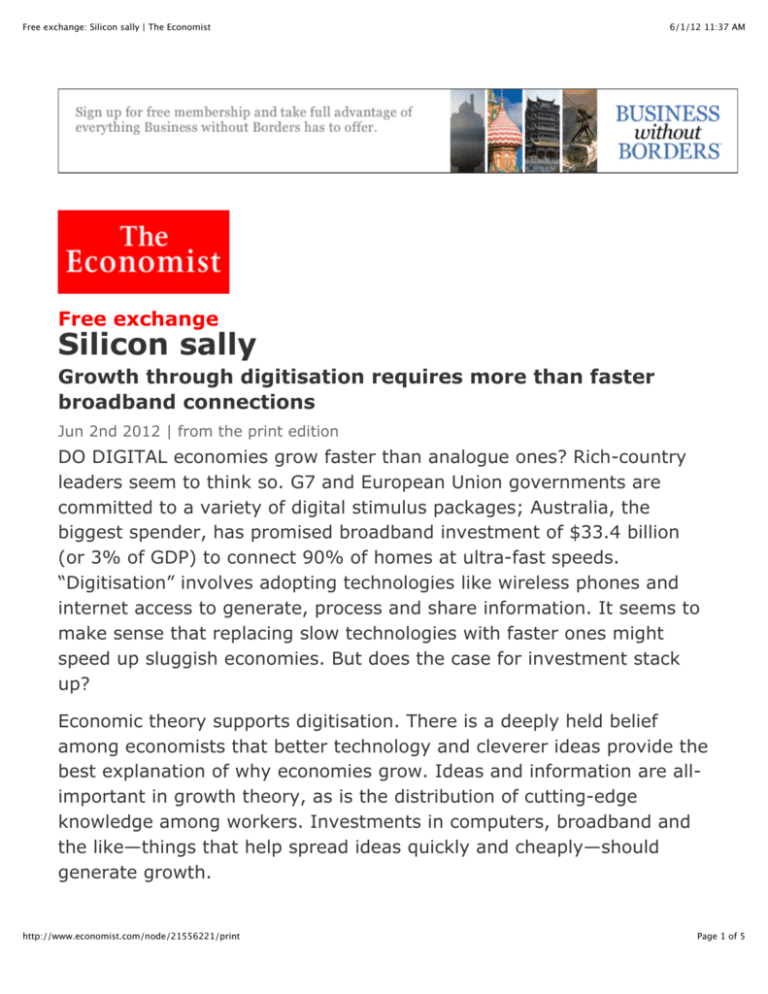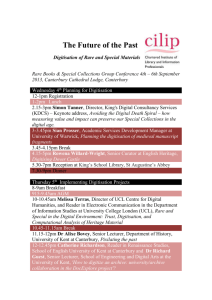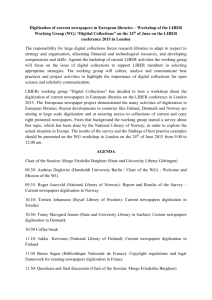
Free exchange: Silicon sally | The Economist
6/1/12 11:37 AM
Free exchange
Silicon sally
Growth through digitisation requires more than faster
broadband connections
Jun 2nd 2012 | from the print edition
DO DIGITAL economies grow faster than analogue ones? Rich-country
leaders seem to think so. G7 and European Union governments are
committed to a variety of digital stimulus packages; Australia, the
biggest spender, has promised broadband investment of $33.4 billion
(or 3% of GDP) to connect 90% of homes at ultra-fast speeds.
“Digitisation” involves adopting technologies like wireless phones and
internet access to generate, process and share information. It seems to
make sense that replacing slow technologies with faster ones might
speed up sluggish economies. But does the case for investment stack
up?
Economic theory supports digitisation. There is a deeply held belief
among economists that better technology and cleverer ideas provide the
best explanation of why economies grow. Ideas and information are allimportant in growth theory, as is the distribution of cutting-edge
knowledge among workers. Investments in computers, broadband and
the like—things that help spread ideas quickly and cheaply—should
generate growth.
http://www.economist.com/node/21556221/print
Page 1 of 5
Free exchange: Silicon sally | The Economist
6/1/12 11:37 AM
Digitisation and growth are also highly correlated. The 15-year period
between 1995 and 2010 was one of strong economic growth and of a
global boom in digitisation. A new index* built by Raul Katz of Columbia
Business School and Pantelis Koutroumpis of Imperial College London
tracks the effects of this boom across countries. The index adds a wider
mix of digitisation metrics than previous rankings, using 21 measures
including broadband speed, coverage and reliability, and the cost and
use of mobile telephones. It also adds to existing indices by measuring
the many ways digital networks can be used, from the availability of
online shopping to the provision of e-government services like road
taxes for cars. Finally, it measures the ability of workers to use new
digital technologies.
Digitisation varies hugely by country and region (see chart). Norway
leads the pack, closely followed by other advanced economies.
Emerging-market digitisation has started to catch up, though in some
countries like India and Indonesia the pace of progress is decidedly dialup. The data also show that there is much further to go on the road to
full digitisation. Globally there are fewer than ten fixed broadband
connections per 100 people; the range runs from close to 40 per 100
people in Hong Kong to below one in Kenya. In some countries, a huge
gap exists between availability and usage. Senegal, for example, has
mobile-broadband coverage for 30% of the population, but only 1% use
it.
Establishing a link between digitisation and growth is one thing; proving
which way causality runs quite another. Growth could be making
consumers richer, so that they buy and use more digital technology. Or
it could be that richer governments are able to invest more. In these
cases growth is causing digitisation, not the other way round. A 2011
paper by Nina Czernich, Oliver Falck, Tobias Kretschmer and Ludger
Wössmann of the University of Munich gets round this problem. The
paper looks at broadband adoption for a group of 25 OECD countries for
the years 1996-2007. The researchers first collect data on the telephone
and cable networks on which broadband depends. Because these
http://www.economist.com/node/21556221/print
Page 2 of 5
Free exchange: Silicon sally | The Economist
6/1/12 11:37 AM
networks predate broadband, any relationship between them and
broadband uptake is independent of
current growth and investment. This
allows the authors to create a strippeddown measure of broadband
penetration, which can then be tested to
see how it affects economic expansion.
The findings are striking: a tenpercentage-point increase in broadband
penetration results in an increase in
annual per-head growth of 0.9-1.5
percentage points. At an aggregate
level, digitisation boosts growth rates.
That suggests the greatest gains from going digital will come in
emerging economies, given their lowly starting-points. Many are acting
accordingly. Brazil has cut taxes, both for firms making digital
technology and for shoppers buying tablet computers. South Korea has
invested hugely in broadband, jumping from 11th to 2nd in the
digitisation rankings. For the growth-hungry policymaker, however,
digital stimulus is not the end of the story.
Analysis that looks more deeply at individual industries finds that
digitisation on its own is not enough. Faster information boosts output
only when matched with more astute ways of interpreting and acting on
new data. American policing is one example: in the late 1980s less than
20% of police forces used computers, but by the early 2000s over 90%
did. Recent analysis by Luis Garicano and Paul Heaton of the London
School of Economics shows that digitisation alone did not improve
policing outcomes. But some forces matched the new computers and
data with better ways of working: more accurate mapping of crime,
daily adjustment of officer deployment to crime hotspots and regular
evaluation of results. Productivity was boosted.
Digitally enhanced
http://www.economist.com/node/21556221/print
Page 3 of 5
Free exchange: Silicon sally | The Economist
6/1/12 11:37 AM
Similarly, some firms are better than others at marrying new digital
technology to fresh ways of operating. A new study by Nicholas Bloom
of Stanford University, Raffaella Sadun of Harvard Business School and
John Van Reenen of the London School of Economics supports the idea
that digitisation alone is not enough to drive growth. Their data show
that American firms tend to have more information technology than
comparable European ones, and are better at squeezing productivity out
of it.
This finding is explained largely by management practices. American
firms are more aggressive in promoting and rewarding high-performing
staff, for instance; they are also quicker to remove underperformers.
Since the ability to monitor and measure performance is improved by
having better technologies, digitisation seems to complement the
American way of managing. This may be one reason why American
productivity growth—concentrated in sectors that use information
technology intensively—has outstripped that in the EU over the past 15
years. The machines matter, in other words, but so do the men.
Sources
“Policy Responses to the Economic Crisis: Investing in Innovation for Long-Term Growth
(http://www.oecd.org/dataoecd/59/45/42983414.pdf) ”, OECD, 2009
P.M. Romer, “Endogenous Technological Change (http://www.jstor.org/stable/2937632) ”, 1990,
Journal of Political Economy 98 (5), S71-S102,
Raul L. Katz and Pantelis Koutroumpis, “Measuring socio-economic digitisation: A paradigm shift
(http://www3.weforum.org/docs/GITR/2012/GITR_Chapter1.11_2012.pdf) ”, unpublished working
paper
N. Czernich, O. Falck, T. Kretschmer and L. Woessman, “Broadband infrastructure and economic
growth (http://onlinelibrary.wiley.com/doi/10.1111/j.1468-0297.2011.02420.x/abstract) ”, 2011,
http://www.economist.com/node/21556221/print
Page 4 of 5
Free exchange: Silicon sally | The Economist
6/1/12 11:37 AM
Economic Journal 121 (552), pp. 505-532
Luis Garicano and Paul Heaton, “Information Technology, Organization, and Productivity in the
Public Sector: Evidence from Police Departments (http://www.rand.org/pubs/reprints/RP1409) ”,
2010, Journal of Labor Economics 28 (1), pp. 167-201
N. Bloom, R. Sadun and J. Van Reenen, “Americans Do IT Better: US Multinationals and the
Productivity Miracle (http://www.aeaweb.org/articles.php?doi=10.1257/aer.102.1.167) ”, 2012,
American Economic Review 102 (1), pp. 167–201
Economist.com/blogs/freeexchange (http://www.economist.com/blogs/freeexchange)
from the print edition | Finance and economics
Copyright © The Economist Newspaper Limited 2012. All rights reserved.
Privacy policy
Cookies info
http://www.economist.com/node/21556221/print
Terms of use
Accessibility
Help
Page 5 of 5







